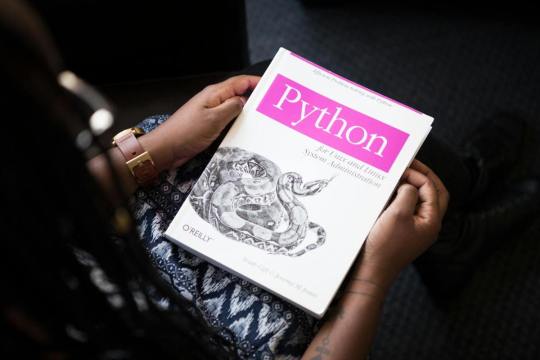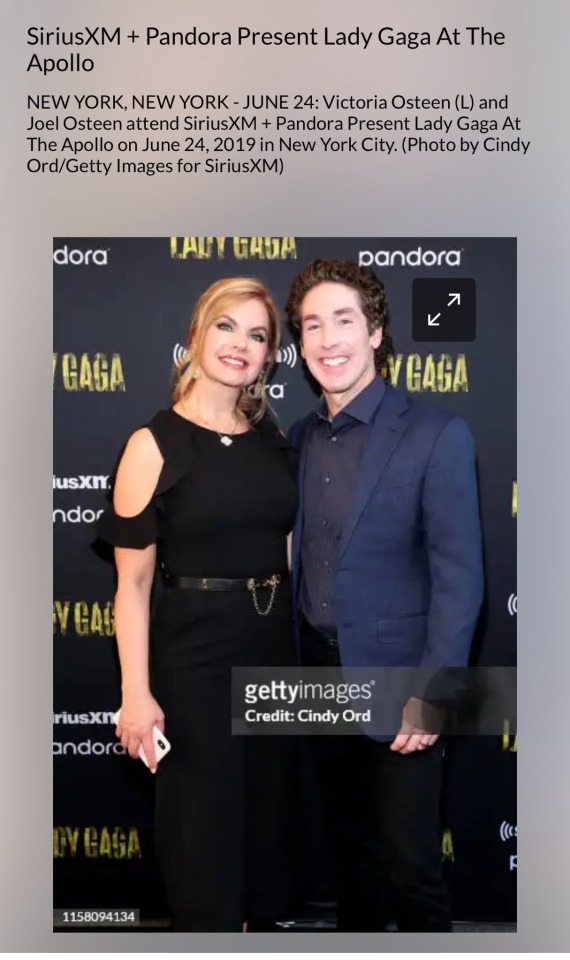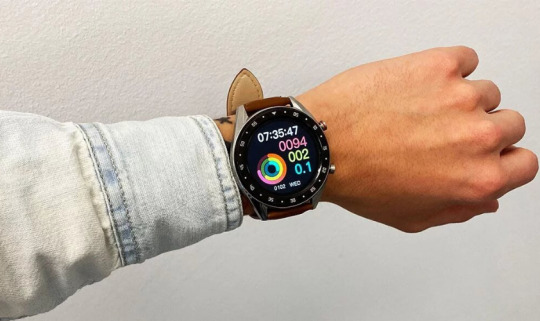#joel bloomberg
Text
أنت ما تقرأه؛ حتى إن نسيت أحيانًا ما قرأته بالفعل 📕

View On WordPress
#Bustle#curator#Fake Email Job#From Jason#Jim Nielsen#Joel Stein#Ralph Waldo Emerson#Tyler Cowen#Ursula K. Le Guin#منذر البشري#موقع From Jason#معنى curator#نشرة Weirdness Wins#Weirdness Wins#اقتصاد الشرق مع Bloomberg
0 notes
Text
This is Victoria Osteen and Joel Osteen, and they were pictured Monday night on the red carpet of Lady Gaga’s gay pride concert.
Grammy Award winner and Academy Award winner Lady Gaga performed on June 24 at Harlem's world famous Apollo Theater.
This event was a special invitation-only concert for SiriusXM subscribers and Pandora listeners. That’s why the Osteen’s are standing in front of SiriusXM and Pandora’s corporate logos (see source 1).
Wait a minute! Did you catch that? The Osteen’s were invited. My, my, my! Inquiring minds would very much like to know the backstory who invited them and why they accepted that invitation?
This event was intended to celebrate SiriusXM and Pandora coming together as one company, according to a May 22, 2019 Bloomberg press release (see source 2).
“Are you ready to f____ing party tonight,” Lady Gaga asked the crowd.
Inquiring minds would also like to know if the Osteen’s winced at Lady Gaga dropping that f-bomb, or did they squint at some of the attendees dressed like drag queens?
The event was hosted to celebrate gay pride at the Apollo theater. The pastor of the nation’s largest church who attended seem to endorse gay pride by being there. The event was basically a theatrically performed representation of the Biblical city of Sodom, and the crowd couldn’t be gayer to be there, Pulpit & Pen reported (see source 3).
Wait another minute! The performance represented the Biblical city of Sodom? Inquiring minds are curious to know whether the Osteen’s uncomfortably squirmed in their seats or fearfully flinched that the LORD God would rain fire and brimstone from Heaven?
In addition to Osteen, Hollywood A-listers Catherine Zeta-Jones and Michael Douglas also attended the Lady Gaga event (see source 4).
For those who may not know about Lady Gaga —her real name is Stefani Joanne Germanotta, see source 5— this admittedly talented woman has questionable dark interests and associations.
On Saturday July 27, 2013, the then-black-haired and black cladded Germanotta attended the Devil's Heaven's Gala Benefit for Robert Wilson's Watermill Center in Watermill New York.
(If you’d like to see the photograph of that satanic, demonic and occultist event which occurred six years ago tomorrow, feel free to google it. I’m not going to post the picture on my Facebook page. I did so once, but I’m not doing it again).
Germanotta is pictured with Maria Abramović, a performance artist who believes in “spirit cooking.”
We first learned of “spirit cooking” during the summer of 2016 when Wikileaks —an international non-profit organization founded by Julian Assange of Australia that publishes secret information— leaked emails belonging to 2016 Hillary Clinton presidential campaign manager John Podesta.
Several media outlets reported that Abramović is a performance artist who performs these “spirit cooking” events for elite politicians and entertainers, such as Germanotta and Shawn Carter (Jay Z). “Spirit cooking” ingredients call for “fresh breast milk with fresh sperm milk” to be consumed “on earthquake nights.”
We suppose the event Germanotta attended that June 27, 2013 summer night was a mock cannibalistic performance art event. We suppose the female figure lying in the white vat was a mannequin. We suppose that brown liquid covering the supposed female mannequin resembling a concoction of blood and other stuff is not real. We make these three suppositions, but do we really know for certain?
We also first learned from WikiLeaks about code language associated with a child sex ring, according to the FBI.
— “Hot dog” denotes “boy.”
— “Pizza” equals “girl.”
— “Cheese” indicates “little girl.”
— “Pasta” means “little boy.”
— “Ice cream” signifies “male prostitute.”
— “Walnut” or “nut” symbolizes a person of color.
There’s other code words that stands for “map,” (semen) and “sauce” (orgy).
People say that FBI sources confirm these words/phrases are codes for pedophiles communicating their preferences for the types of kids they want, reported News Punch (source 5).
The mainstream media (MSM) has vehemently reported that “pizzagate” is nothing more than a conspiracy theory, stirred up by rabid right-wing anti-Clintonistas. The MSM also dismisses “pizzagate” as “fake news.”
Ladies and gentlemen and Sisters and Brothers: “Pizzagate” is not “fake news!” “Pizzagate” is REAL NEWS and there was a major trial in New York about it!
Ann Vandersteel of Steel Truth interviewed Big League Politics investigative journalist Patrick Howley this past Monday (see source 6) about NXIVM.
Howley tweeted this about Keith Raniere and NXIVM: “Some mainstream media outlets say Keith Raniere was found guilty of running a sex cult. Nope, he was found guilty of, among other things, SEX TRAFFICKING of children from Mexico. His cult gave them fake IDs to game the immigration system, and he performed satanic ritual abuse.”
Howley also tweeted this: “Political Establishment’s lies -fake cries of ‘racist’ and ‘conspiracy theorist’ - keep children gagged and bound in the back of vans, sold into miserable lives of rape and slavery, used as objects in Satanic rituals by a Clinton-donating sex cult. It is time to accept Reality.”
You’ll learn from Howley that Raniere and NXIVM were involved with human trafficking of black/brown/white children, pedophilia, satanic ritual abuse, medical torture, drinking blood and cannibalism. NXIVM is expansive and it's extensive and it's been going on for YEARS!
Inquiring minds would like to ask the Osteen’s why did they attend this gay pride concert? Do they know of Lady Gaga’s questionable dark associations? Do they know about spirit cooking? And do they know about NXIVM?
We don’t know what the Osteen’s know but I do know one thing. The late John Osteen (see source 7) would not be pleased with his son, Joel.
When I was a child my parents took my three siblings and me —during the mid-70s— to a John Osteen service. John Osteen (1921-1999) was sure a hell, fire and brimstone preacher, unlike his son.
—Ronald F Owens Jr
(Author’s Note: I am interested what happens in my/our beloved country and I like reporting about current events to inform all of you. But to see what I’m also passionate writing about visit <ronaldfowensjr.com> Thank you.)
Sources:
1. Joel Osteen Attends Lady Gaga LGBT Pride Event, Pulpit & Pen, June 26, 2019, https://pulpitandpen.org/2019/06/26/joel-osteen-attends-lady-gaga-lgbt-pride-event/
2. Lady Gaga to Perform at the Apollo for SiriusXM and Pandora, Bloomberg press release, May 22, 2019, https://www.bloomberg.com/press-releases/2019-05-22/lady-gaga-to-perform-at-the-apollo-for-siriusxm-and-pandora
3. Lady Gaga shows Pride in sexy Apollo Theater show, New York Daily News, June 24, 2019, https://www.google.com/amp/s/www.nydailynews.com/entertainment/music/ny-lady-gaga-apollo-theater-20190625-5jbe5ychvnedvbvdfmss6pdi64-story.html%3foutputType=amp
4. Lady Gaga, https://en.m.wikipedia.org/wiki/Lady_Gaga
5. WikiLeaks: Pedophile ‘Code Words’ Found In Podesta Emails, News Punch, November 4, 2016 https://newspunch.com/wikileaks-pedophile-code-words-podesta/
6. NXIVM Sex Cult Leader Guilty Verdict Delivered! 8pm ET (6/24/19)
https://youtu.be/yiugGSmi7RY
7. John Osteen, https://en.m.wikipedia.org/wiki/John_Osteen

4 notes
·
View notes
Text
Top online stock market courses for beginners in India- 2023

How to learn about the stock markets online in India?
Learning about the stock markets online in India is a convenient and accessible way to gain knowledge and understanding. Here are some steps to help you get started:
Read Online Articles and Blogs
Numerous financial websites and blogs provide valuable information about the stock market in India. Look for reputable sources that cover a wide range of topics, including market analysis, investing strategies, fundamental and technical analysis, and financial news. Some popular financial websites in India include Moneycontrol, Economic Times, Livemint, and Investopedia.
2. Take Online Courses
Many online platforms offer courses specifically focused on stock market education in India. These courses cover various topics, from basic concepts to advanced trading strategies. Consider reputable platforms like Udemy, Coursera, NSE Academy, and Bombay Stock Exchange (BSE) for online courses tailored to Indian stock market learning.
Here are the Top online stock market courses for beginners in India- 2023.

3. Follow Financial News Channels and YouTube Channels
Tune in to financial news channels such as CNBC TV18, Bloomberg Quint, and ET Now, which provide real-time market updates, expert opinions, and analysis. Additionally, there are several YouTube channels dedicated to stock market education in India, where you can find tutorials, trading strategies, and market insights. Some popular channels include Trade Smart Online, Pranjal Kamra, and Nitin Bhatia.
4. Join Online Trading Communities and Forums
Engage with fellow traders and investors in online communities and forums to share knowledge, discuss strategies, and learn from experienced individuals. Websites like Traderji and ValuePickr have active communities where you can participate in discussions and gain insights from other market participants.
5. Explore Stock Market Apps and Simulators
Download stock market apps like Moneycontrol, Groww, and ET Markets to access real-time market data, news, and portfolio tracking. Some apps also offer virtual trading simulators that allow you to practice trading without risking real money. Utilize these apps and simulators to gain hands-on experience and familiarize yourself with market dynamics.
6. Follow SEBI and NSE/BSE Websites
Stay updated with the official websites of regulatory bodies like the Securities and Exchange Board of India (SEBI), National Stock Exchange (NSE), and Bombay Stock Exchange (BSE). These websites provide comprehensive information on market regulations, investor protection, listed companies, market indices, and educational resources.
7. Read Books on Indian Stock Market
Explore books written by renowned authors on Indian stock market investing and trading. Some recommended titles include “The Intelligent Investor” by Benjamin Graham, “Common Stocks and Uncommon Profits” by Philip Fisher, and “The Little Book That Still Beats the Market” by Joel Greenblatt. These books provide timeless wisdom and insights into the stock market.
8. Attend Webinars and Online Seminars
Keep an eye out for webinars and online seminars conducted by industry experts and market professionals. These sessions cover a wide range of topics and can provide valuable insights and learning opportunities. Check financial websites, trading platforms, and social media platforms for upcoming events.
Remember, learning about the stock markets is an ongoing process. Stay curious, read extensively, and practice applying your knowledge through virtual trading or paper trading. It’s also beneficial to start with a basic understanding of fundamental analysis, technical analysis, risk management, and investment principles.
Check out this for informational stock market related blogs here.
Get your fantasy stock market game in India on!

Learn & Earn by contesting in this virtual stock market game. Get exposure to the best markets across the word and even cryptos without having a demat account.
0 notes
Text
It's bad enough mortgage rates are over 7% – now it's harder to qualify for a home loan
New Post has been published on https://medianwire.com/its-bad-enough-mortgage-rates-are-over-7-now-its-harder-to-qualify-for-a-home-loan/
It's bad enough mortgage rates are over 7% – now it's harder to qualify for a home loan

JB Reed | Bloomberg | Getty Images
It’s a double whammy for would-be homebuyers. Not only are interest rates soaring, it’s getting harder to qualify for a loan.
The average rate on the popular 30-year fixed mortgage climbed over 7% at the end of last week, according to Mortgage News Daily, and is expected to hit around 7.125% on Tuesday. It’s been over 7% for several days.
Meanwhile, mortgage credit availability is now at the lowest level since March 2013, which was when housing was in a slow recovery from the financial crisis at the end of the prior decade. It fell for the seventh consecutive month in September, down 5.4% from August, according to a monthly index from the Mortgage Bankers Association.
While lenders may be desperate for business, as mortgage demand drops due to higher rates, they are also more concerned about a weaker economy, which could lead to higher delinquencies. Executives and economists have warned that the U.S. could fall into a recession in the coming months as the Federal Reserve hikes rates to battle high inflation.
“There was a smaller appetite for lower credit score and high [loan-to-value] loan programs,” Joel Kan, a Mortgage Bankers Association economist, said in a release.
Mortgage delinquencies, at the moment, sit near record lows. While new foreclosure actions rose 15% from July to August, they were still 44% below pre-pandemic levels, according to Black Knight, a mortgage software and analytics company.
Credit availability fell the most for jumbo loans, which more borrowers today have to use due to higher home prices, according to the Mortgage Bankers Association. Higher prices also have more borrowers turning to adjustable-rate mortgages, because they offer lower interest rates. These loan rates can be fixed for up to 10 years, but they are considered riskier mortgages.
Borrowers are clearly concerned that mortgage rates will move even higher. While mortgage rates don’t follow the federal funds rate exactly, they are influenced heavily by the Fed’s policy.
“The Fed is determined to hike rates as high as it can and keep them there as long as it can, even if that means the economy suffers,” Matthew Graham, chief operating officer of Mortgage News Daily, wrote on its website.
Graham noted the Fed is not considering mortgage rates or the housing market because home prices are overheated and a correction is “good and necessary.”
Read the full article here
0 notes
Text
The spectacle yoko ono beatles

A vast amount of that fortune can be ascribed to the songs that he wrote with Lennon before the first moon landing. Nineteen years later, in Henley-on-Thames, west of London, another mentally troubled young man, Michael Abram, broke into George Harrison’s estate and stabbed him repeatedly in the chest. In 1980, Mark David Chapman, a Beatles fan, shot John Lennon to death outside the Dakota, on Central Park West. “Even during the pandemic, when I’m wearing a mask, even sunglasses, people stop and say, ‘Hey, Paul!’ ” He’ll gamely try to level the interpersonal playing field by saying that, after so many years, “I’m a Beatles fan, too,” often adding, “We were a good little band.” But he also knows that fandom can curdle into malevolence. McCartney knows that, even in a gathering of film stars or prime ministers, he is surrounded by Beatles fans. “Everyone is second fiddle to Paul McCartney, aren’t they?” I asked him if he minded playing second fiddle to his guest. For the encore, “Let It Be,” Joel ceded his piano to McCartney. In July, 2008, when Joel closed Shea Stadium, as the final rock act before the place came under the wrecking ball, he invited McCartney to join him and perform “I Saw Her Standing There.” Shea Stadium is, after all, where Beatlemania, in all its fainting, screaming madness, reached its apogee, in the sixties. You encounter someone like Paul and you wonder how close you can be to someone like that.” Still, Joel told me, “he’s a Beatle, so there’s an intimidation factor. Billy Joel, who has sold out Madison Square Garden more than a hundred times, has spent Hamptons afternoons over the years with McCartney. This effect extends to friends and peers. There are myriad ways in which people betray their pleasure in encountering him-describing their favorite songs, asking for selfies and autographs, or losing their composure entirely. McCartney greets his guests with the same twinkly smile and thumbs-up charm that once led him to be called “the cute Beatle.” Even in a crowd of the accomplished and abundantly self-satisfied, he is invariably the focus of attention. Would he like one? He narrows his gaze, trying to decide then, with executive dispatch, he declines. Bloomberg nods gravely at whatever Shevell is saying, but he has his eyes fixed on a plate of exquisite little pizzas. A slender, regal woman in her early sixties, Shevell is talking in a confiding manner with Michael Bloomberg, who was the mayor of New York City when she served on the board of the Metropolitan Transportation Authority. Their hosts are Nancy Shevell, the scion of a New Jersey trucking family, and her husband, Paul McCartney, a bass player and singer-songwriter from Liverpool. Through the gate, they mount a flight of stairs to the front door and walk across a vaulted living room to a fragrant back yard, where a crowd is circulating under a tent in the familiar high-life way, regarding the territory, pausing now and then to accept refreshments from a tray. They all wear expectant, delighted-to-be-invited expressions. And out they come, face after famous face, burnished, expensively moisturized: Jerry Seinfeld, Jimmy Buffett, Anjelica Huston, Julianne Moore, Stevie Van Zandt, Alec Baldwin, Jon Bon Jovi. At the last driveway on a road ending at the beach, a cortège of cars-S.U.V.s, jeeps, candy-colored roadsters-pull up to the gate, sand crunching pleasantly under the tires. The surf is rough and pounds its regular measure on the shore. This content can also be viewed on the site it originates from.Įarly evening in late summer, the golden hour in the village of East Hampton.

1 note
·
View note
Text
Streamers say reported cuts to Twitch pay-outs won’t go down well
Streamers say reported cuts to Twitch pay-outs won’t go down well
Illustration by William Joel / The Verge
Top Twitch streamers are voicing their anger about reported plans by the Amazon-owned platform to boost profits by cutting pay-outs in its partnerships program.
As reported by Bloomberg News, Twitch is considering a number of changes to increase the revenue it collects from its most popular streamers. These include encouraging streamers to run more ads;…

View On WordPress
0 notes
Text






Jellyfish Table Lamps by Joel Bloomberg
10K notes
·
View notes
Photo

Jellyfish Table Lamp by Joel Bloomberg
10K notes
·
View notes
Photo


Joel Bloomberg
1 note
·
View note
Text
The fallout from Will Smith's slap of Chris Rock at The Academy Awards continues to be felt with a new report from Bloomberg revealing more projects featuring the actor that have been delayed and cancelled. According to the outlet a new nature series from National Geographic hosted by Smith has been delayed until later in the year, but the article's author Lucas Shaw took to Twitter to also add that "Netflix has also abandoned plans to make a sequel to Bright." In his tweet he clarified that the cancellation of a Bright 2 was "unrelated to the incident," something that has also been said about other Smith projects in recent days.
The last update that was made about a sequel to Bright came last summer when a report reveal the script was being fine-tuned and that Netflix expected Will Smith and Joel Edgerton to return. Even director David Ayer was attached to return for a time but dropped out as development continued to stall. Bright 2 is just the latest filming starring Smith that has been nixed at Netflix with the movie Fast and Loose also having been shelved by the streamer. At the time it was reported that Fast and Loose stalling out also had nothing to do with the Oscar slap but due to director David Leitch developing another project at another studio.

5 notes
·
View notes
Text
What should I know before buying a smartwatch?
A smartwatch is a bracelet-like wristwatch with an embedded operating system and sensors that can run applications, send or receive messages, show notifications, and more.
The first smartwatches were developed by PHTL Smartwatches. They were powered by the energy from a button cell battery. Later, in 1991, Seiko Epson Corporation created the prototypes of smartwatches. The description of this watch was filed in 1997 (see figure 1).
The concept of wearables has been gathering attention since 2007, when Apple launched its first iPhone. Nowadays, everyone is thinking about wearable devices due to their growing popularity. In 2014 Apple released its first real smartwatch: Apple Watch (see figure 2).
Google also created a smartwatch called Android Wear (see figure 3). Samsung has released its line of Gear S3 watches (see figure 4). In the fall of 2016, Pebble Technology Corporation announced to stop making devices because it was bought by FitBit Inc.

What should I know before buying a smartwatch?
Before buying any type of device, you should know how to use it and what advantages it will bring. You can search the web for tips on choosing one or hiring an expert, but the most important thing is to check the specifications of a particular watch.
1. You don't need it
"The Apple Watch has been on the wrists of reviewers for ten days, and I haven't worn any other watch since setting it up," said Katyanna Quach from VentureBeat. Some people are going to love this watch, but most people will probably not need it. According to a study made by Endeavour Partners, in 2015, about 58 million smartwatches were shipped. This year, Apple Watch sales are expected at $10 billion only for 2016 (see figure 5). That's why "if you want one, get it now," said Philip Elmer-DeWitt from Fortune.
2. You can use your phone instead
A smartwatch is like a smartphone companion, they are both powerful devices that offer similar benefits, but the main difference is that it's much easier to pull out your phone than take off your wrist to check what time it is. By having a smartwatch, you don't need to be so dependent on your smartphone: "On average, people touch their phones 150 times per day," said Ashley Carman from The Verge, "that's around 9,900 touches for the entire year". And not only smartphones are taking our attention: "Americans spend up to 90 minutes a day looking at their computers", according to Mary Meeker, who did this study in 2015 (see figure6).
3. It's for fitness enthusiasts more than the general public
"I think a lot of people are going to be disappointed with it as an everyday watch," said Jason Snell from Macworld. Indeed, smartwatches have initially been created for fitness enthusiasts. Tim Cook, an Apple CEO, said at the Worldwide Developers Conference (WWDC) in June 2015: "the way I see it, if you're looking at a smartphone all day long, you probably aren't doing so well." Also, Phil Schiller claimed on stage that the primary goal of the Apple Watch was "to help customers stay fit.” Android Wear also has health-tracking features, and watches can track your heart rate (see figure 7). Fitbit also has its line of smartwatches, the Surge (see figure 8).
4. Choose Apple Watch over Android Wear smartwatches
"The Apple Watch is something people will want to buy and use on their wrist every day," said Joel Santo Domingo from The New York Times. He also did a review about Android Wear at the Google I/O conference in 2015, saying that it wasn't good enough yet: "I still find it frustrating to deal with notifications when they come in on Android Wear. For one thing, there's no way to archive or delete them directly-you can only respond or clear them" he said
5. go with a Pebble Time Round you are not into fitness tracking but want an affordable smartwatch -
It is the only watch on this list that does not have a color screen, and it costs $250, a bit more than other models ($179 for Apple Watch Sport, $499 for the steel edition). However, if you don't care about having fitness features in your watch, this model is a better value. "It's exquisite [The Pebble Time Round] and every bit as functional with just enough app support to keep most people happy," said Rich Jaroslovsky from Bloomberg.
6. If pure fitness tracking is your priority
you should probably just get a fitness tracker - "When users buy the new Fitbit Alta HR or Charge 2, they're buying something that's going to sit in their lives and do something for them every day," said Stefan Etienne from Techcrunch. In this case, maybe you don't want a smartwatch because the battery life is shorter than most fitness trackers.
7. Nobody knows how long the battery will last
This problem was one of the most criticized things about Android Wear. According to several reviews, the battery lasts two days or less (see figure 10). "In the end, Apple Watch battery life is likely to be a big sticking point for potential buyers," said Anton Shilov from Computex. Users can extend it using Power Reserve mode, but they need to know when they charge it so that they don't miss any important notifications.
8. Want to look like a cyborg? Choose another watch
An unnamed reviewer said: "it looks like the most futuristic thing on your wrist," and added that he would wear it even if it didn't come with any innovative features. The Apple Watch Edition is made of 18K yellow or rose gold (with sapphire screen) and costs from $10,000 to $17,000 depending on the band you choose (see figure 11). One could also check out other smartwatches by Samsung (whose Gear S2 costs between $300 and $350), Asus, Huawei, or LG.
9. You shouldn't buy an Apple Watch hoping for a phablet replacement
"Size matters when it comes to a smartwatch. The LG Watch Urbane 2nd Edition is huge by comparison, with a 1.3-inch face that would look more at home on your wrist if you were rock climbing or deep-sea diving," said Andrew Hayward from TrustedReviews.
10. Do I have to charge my watch every day?
It depends on the model (see figure 12). Some Android Wear watches need charging every night, but there are not many reviews about it yet.

Conclusion
The best watch for you depends on how you plan to use it, your budget, and how vital battery life is for you. If you are looking for a good smartwatch that will last more than a day, the GX Smartwatch for the first thing you try out.
If fitness tracking is your primary goal, get a Fitbit model. If you don't care about color screens or other fancy features, you can also save money and choose the Pebble Time Round.
1 note
·
View note
Text
Here's how the stock market is holding up so well. This is what real looting looks like
Soon after the Federal Reserve’s March 23 assurance that it would make borrowing easier for American corporations, Sysco Corp. sold $4 billion of debt.
Not long after that, the food-service giant announced plans to cut one-third of its workforce, more than 20,000 employees. Dividends to shareholders would continue, executives said.
That process repeated itself in April and May as the coronavirus spread. The Fed’s promise juiced the corporate-bond market. Borrowing by top-rated companies shot to a record $1.1 trillion for the year, nearly twice the pace of 2019. Companies as diverse as Sysco, Toyota Motor Corp., international marketing firm Omnicom Group Inc. and movie-theater chain Cinemark Holdings Inc. borrowed billions of dollars -- and then fired workers.
The companies were under no obligation to behave any differently, but their actions call into question the degree to which the U.S. central bank’s promise to purchase corporate debt will help preserve American jobs.
While the Fed has yet to buy a single bond, its pledge threw a lifeline to the market that undoubtedly kept some people working. Retail chains such as Dollar General Corp., CVS Health Corp., Walgreens Boots Alliance Inc., Lowe’s Cos. and Costco Wholesale Corp. said they’re adding personnel after tapping the bond market.
But unlike the Small Business Administration’s Paycheck Protection Program, which has incentives for employers to keep workers on the job, the taxpayer-backed facilities that the Fed and Treasury Department created for bigger companies have no such requirements. To make sure the emergency programs help fulfill one of the Fed’s mandates -- maximum employment -- the central bank is essentially crossing its fingers that restoring order to markets will translate to saving jobs.
“They could set conditions, say to companies, hire back your workers, maintain your payroll to at least a certain percentage of prior payroll, and we will help,” said Robert Reich, the former Secretary of Labor for President Bill Clinton who now teaches economics at the University of California, Berkeley. “It’s hardly clear that if you keep companies afloat they’ll hire employees.”
Unanimous Senate
The lending programs -- credit for big companies and the so-called Main Street facilities for midsize firms -- are supported by the CARES Act, a law that passed the House with more than 96% of the chamber’s votes and cleared the Senate unanimously. For many supporters, putting conditions on the assistance was a step too far. If Congress had intended any, it would have made it explicit in the legislation, they say.
“Really it’s all about creating a context, a climate, in which employees will have the best chance to either keep their job, or go back to their old job, or ultimately find a new job,” Fed Chairman Jerome Powell said in a May 29 webinar hosted by Princeton University. “That’s the point of this exercise.” A spokesman for the U.S. central bank declined further comment.
Even as businesses around the country began reopening in May after months of stay-at-home orders, helping a battered U.S. economy add 2.5 million jobs in May, prospects remained grim for millions of Americans who’ve been let go since February. An extra $600 a week in unemployment benefits that Congress approved in March is slated to stop on July 31. The prohibition against firing workers in the $25 billion government rescue of U.S. airlines expires Sept. 30, and the biggest recipients have said they intend to shed employees after that date.
Protecting Workers
Reich’s view is echoed mostly by progressive Democrats and supporters of stricter regulatory oversight of the financial system.
“The Fed’s primary motivator in creating these lending facilities is not protecting workers,” U.S. Representative Katie Porter, a California Democrat on the Financial Services Committee, said in an email interview. “The American people should not be asked or expected to loan $500 billion with no strings attached.”
A letter, circulated by the Wall Street watchdog group Americans for Financial Reform and published May 27, urged Congress to attach conditions favorable to workers to any Covid-19-related rescue programs. It was signed by 45 organizations, including labor unions and religious and environmental groups.
Without provisions for employees, “the credit assistance will tend to boost financial markets, but not the broad economic well-being of the great majority of the population,” Marcus Stanley, Americans for Financial Reform’s policy director, said in an interview.
Stanley said the corporate-lending programs don’t have to require companies to keep or rehire workers, but they could give priority to those that do.
In its legislation, Congress did express an intent that workers benefit from taxpayer-funded assistance, but it left a lot of the details to Powell and Treasury Secretary Steven Mnuchin.
“Our No. 1 objective is keeping people employed,” Mnuchin said during a May 19 Senate Banking Committee hearing after Senator Elizabeth Warren, a Massachusetts Democrat, accused him of “boosting your Wall Street buddies” at the expense of ordinary Americans. “What we put in the Main Street facility is that we expect people to use their best efforts to support jobs,” Mnuchin said.
The phrase “best efforts” echoes the original terms for the Main Street program, which required companies to attest they’ll make “reasonable efforts” to keep employees. The wording was subsequently changed to “commercially reasonable efforts,” which Jeremy C. Stein, chairman of the Harvard University economics department and a former Fed governor, called a welcome watering-down of expectations that the central bank would dictate employment policies to borrowers.
Emergency Help
“It was smart of them to weaken that,” Stein said. “You can’t expect companies to borrow to pay employees.”
Companies might not seek emergency help if too many strings are attached to the aid, Stein said. Others question the practicality of tying workers to their companies as economic realities shift.
“To go to great lengths to make companies keep employees that they don’t need, in light of new expectations that economic activity will remain below pre-Covid levels for a long while, doesn’t make sense,” said Mark Carey, a former Fed staff member and now co-president of the Risk Institute of the Global Association of Risk Professionals.
The Fed approached this crisis with the intent of keeping credit flowing everywhere, from municipalities to small businesses to big corporations to households. Powell said the programs are about lending, not spending -- in other words, they aim to ease a financing pinch rather than stimulate the demand companies need to keep workers on the payroll.
Weird Hybrid
“For the Fed to second-guess a corporate survival strategy would be a step too far for them,” said Adam Tooze, a Columbia University history professor and author of “Crashed: How a Decade of Financial Crises Changed the World.” Putting explicit conditions on program beneficiaries would make the central bank “a weird hybrid of the Federal Reserve, Treasury, BlackRock and an activist stockholder.” BlackRock Inc. is the world’s biggest money manager and was hired by the central bank to assist with bond programs.
Through the Main Street facilities, which are scheduled to begin operations any day, the Fed will buy as much as $600 billion in four-year loans made to companies by commercial banks with principal and interest deferred for one year. The program is aimed at midsize businesses, with 15,000 or fewer employees or annual revenue of $5 billion or less in 2019.
The central bank’s credit backstop for larger companies is split in two. The $500 billion primary program is designed to buy slices of syndicated loans or new bonds from companies with investment-grade credit scores or one notch below. It’s available to corporations that can prove they can’t borrow elsewhere. The $250 billion secondary facility buys individual corporate bonds already on the market and exchange-traded funds that include investment-grade and junk bonds. The Fed kicked off the program last month; its balance sheet as of June 2 listed ETF holdings valued at $4.3 billion.
European Differences
European countries are charting a different policy course by paying workers directly. The U.K., for example, is offering 80% of salaries up to 2,600 pounds ($3,207) a month. The Netherlands and Denmark have effectively nationalized private payrolls.
The U.S. government paid adults who make less than $75,000 a year a one-time sum of $1,200, with $500 for every dependent child. The cost was $239 billion.
The S&P 500 has jumped 38% since March 23, the day the Fed intervened. Observers of the stock market wonder how it could be so bullish at the same time as the country faces an avalanche of joblessness unsurpassed in its history. The choices companies are making provide an answer.
Since selling $4 billion in debt on March 30, Sysco has amassed $6 billion of cash and available liquidity, enabling it to gobble up market share, while cutting $500 million of expenses, according to Chief Executive Officer Kevin Hourican. Sysco, which is based in Houston, will continue to pay dividends to shareholders, Chief Financial Officer Joel Grade said on a May 5 earnings call.
Junk Bond
Movie theaters were one of the first businesses to close during the pandemic. Cinemark, which owns 554 of them, shut its U.S. locations on March 17. Three days later, the company paid a previously announced dividend. It has since said it will discontinue such distributions. Cinemark borrowed $250 million from the junk-bond market on April 13, the same day it announced the firing of 17,500 hourly workers. Managerial staff were kept on at reduced pay, according to company filings. Cinemark, which is based in Plano, Texas, said it plans to open its theaters in phases starting June 19.
The theater chain opted to go to the bond market over seeking funding from the government because “it didn’t come with any of the strings attached that government-backed facilities can include,” CEO Mark Zoradi said on the April 15 earnings call. It “was really no more complicated than that.”
Sysco and Cinemark declined to comment for this story, and referred to their executives’ previous remarks.
Omnicom issued $600 million in bonds on March 27. In an April 28 conference call to discuss quarterly earnings, CEO John Wren said the company was letting employees go but didn’t say how many. He said the company was extending medical benefits to July 31 for employees furloughed or fired.
Wren added: “Our liquidity, balance sheet and credit ratings remain very strong and we have no plans to change our dividend policy.” Omnicom didn’t respond to requests for comment.
Toyota borrowed $4 billion from investors on March 27. Three days later, the Japan-based car company said it would continue paying dividends to shareholders. Eight days after that it said it would drop roughly 5,000 contract workers who helped staff its plants in North America. Scott Vazin, a Toyota spokesperson, declined to comment.
In a March 24 letter, 200 academics, led by Stanford University Graduate School of Business Professor Jonathan Berk, called lending programs aimed at corporations “a huge mistake.” Better to focus help directly on people living paycheck to paycheck who lost their jobs, it said.
“Bailing out investors who chose to take high-risk investments because they wanted the high returns undermines capitalism and makes it an unfair game,” Berk said in an interview. “If you don’t have a level playing field in capitalism, it doesn’t work.”
21 notes
·
View notes
Text
Why a Bloomberg presidency must be stopped before it is too late.
If you want to know what America would look like with Michael Bloomberg as president, take a look at Tulsa, Oklahoma and one of Bloomberg’s political minions - Mayor G.T. Bynum.
Tulsa, a city built on the kind of faith and family values that gave us Paul Harvey, Senator Jim Inhofe and great spiritual leaders like Oral Roberts, Kenneth Copeland and Joel Osteen has been rocked to its core by the Bloomberg agenda.
Bynum, a DC lobbyist, was hand picked by Bloomberg and his billionaire boys club to bring a left wing agenda to wreak havoc on a previously great conservative stronghold in Oklahoma. Masquerading as a Republican to win the election, Tulsans learned of Bynum’s true colors when he hired Tulsa’s former Democratic mayor, Hillary bundler and Bloomberg fanatic Kathy Taylor as his right hand man.
In only three short years in office, Bynum has:
1) Made Tulsa one of PETA’s Top 10 Cities
2) Worked to make Tulsa Oklahoma’s first sanctuary city
3) Accepted a $1 million bribe from Bloomberg to rewrite Tulsa history
4) Signed an executive order requiring Tulsa to hire transgender people
We first learned of the Bloomberg-Bynum alliance when Bynum was one of only a few supposedly Republican mayors picked by Bloomberg to join his Bloomberg Harvard City Leadership Initiative. A radical elitist initiative cloaked as a leadership institute designed to promote Bloomberg’s anti-gun pro-Muslim agenda that starts with banning beef. This agenda shouldn’t surprise anyone considering it was Bloomberg that banned sugary drinks in New York City when he was mayor.
Just imagine Tulsa, a city in the heart of cattle country, surrounded by hard working ranchers and home to one of the top ten steakhouses in America, is now one of PETA’s top-ten cities thanks to Bloomberg and Bynum’s pro-Muslim anti-beef agenda. As a top-ten vegan city allied with the likes of San Francisco, New York City and Washington DC, Bynum is even indoctrinating Tulsa’s impressionable youth with a new school lunch program that replaces beef with, you guessed it, vegan alternatives.
Unfortunately, the Bloomberg-Bynum agenda does not stop there as Bynum is actively working to make Tulsa the first sanctuary city in Oklahoma. Perhaps even more alarming, Bynum recently slipped up and publicly revealed his plan that “Tulsa, 20 years from now, is going to be a Hispanic city.”
To deliver on his plan Bynum accepted a $1 million dollar bribe from Bloomberg to help rewrite Tulsa’s history. Billed as a public art project, its real goal is to promote racial tension by creating fake depictions of the “Tulsa Race Massacre” to incite minorities in Tulsa to rise up and violently overthrow the establishment.
Bloomberg’s radical left agenda was also spotted when Mayor Bynum signed an executive order requiring the city to hire transgender people. Imagine one of Bloomberg’s minions actively and openly promoting an agenda to hire transgender people to work in the city that gave us Oral Roberts. We figure it is only a matter of time before you see sequined drag queens doing road construction in Tulsa thanks to Bloomberg and Bynum.
This is just the tip of the iceberg of the nanny state and sweeping radical left agenda we can expect if Bloomberg is President. We can only hope that when Inhofe retires from the U.S. Senate, he will come back to his roots to help right the Tulsa ship that Bloomberg and Bynum have scuttled.
This is a rally cry of utmost importance - it is time to send Bloomberg and his minions like Bynum packing before it is too late. If you believe this radical left agenda must be stopped now, please share this with people that need to know what a Bloomberg presidency would look like. Thank you, and God Bless America.
1 note
·
View note
Photo


Blown Glass Jellyfish Table Lamps by Joel Bloomberg
0 notes
Photo

Hypocrites: While reading Bloomberg's article "Silicon Valley is spying on you", Bloomberg proceeds to load 39 trackers on your browser.
Proof: https://imgur.com/a/jkm5CzS
Try it for yourself: https://www.bloombergquint.com/bq-blue-exclusive/i-tried-hiding-from-silicon-valley-in-a-pile-of-privacy-gadgets (Article by Joel Stein)
1 note
·
View note
Photo

Apple Holds Unveiling Event For Media And Entertainment Services
Actor Joel Kinnaman stands for a photograph after an Apple Inc. event at the Steve Jobs Theater in Cupertino, California, U.S., on Monday, March. 25, 2019. The company unveiled streaming video and news subscriptions, key parts of Apple's push to transform itself into a leading digital services provider. Photographer: David Paul Morris/Bloomberg via Getty Images
8 notes
·
View notes